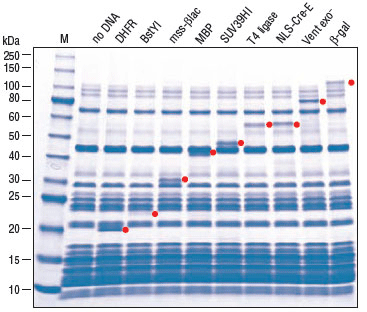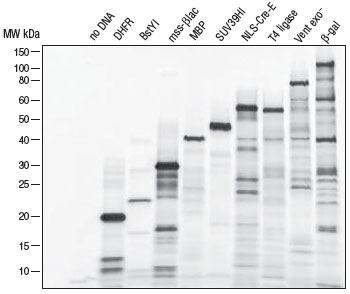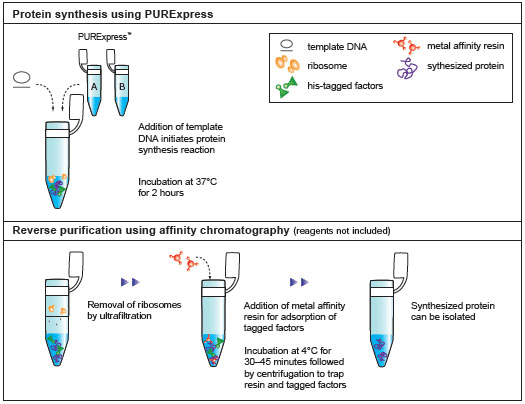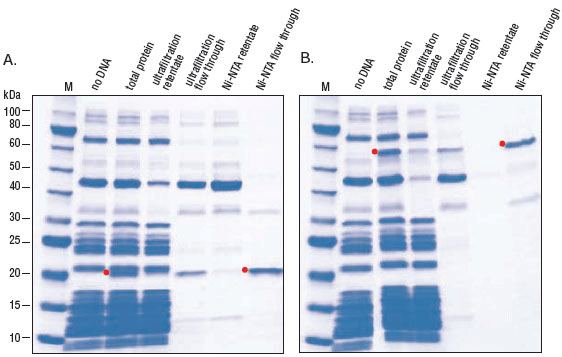PURExpress® Δ RF123 Kit
Product information| Code | Name | Size | Quantity | Price | |
|---|---|---|---|---|---|
E6850S |
PURExpress Delta RF123 Kit |
10 rxns | - | Unavailable in your region |
PURExpress® Δ RF123 Kit
Product Introduction
PURExpress® Δ RF123 kit is a variation of the PURExpress In vitro Protein Synthesis Kit where the release factors 1, 2 and 3 are omitted from the translation mix.
- RF1, RF2 and RF3 are supplied separately to allow users to control protein synthesis with/without release factors of their choice
- Essentially RF1 and RF3 free, RF2 is greatly reduced to minimal levels
- Allows for robust recovery of activity-encoding nucleic acid template in library screening applications
- Applications include non-natural amino acid incorporation, ribosome display and mRNA display
| Catalog # | Size | Concentration |
|---|---|---|
| E6850S | 10 reactions |
- Product Information
- Protocols, Manuals & Usage
- Tools & Resources
- FAQs & Troubleshooting
- Citations & Technical Literature
- Quality, Safety & Legal
- Other Products You May Be Interested In
Product Information
Description
A rapid method for gene expression analysis, PURExpress® is a novel cell-free transcription/translation system reconstituted from the purified components necessary for E. coli translation. With minimal nuclease and protease activity, the PURExpress system preserves the integrity of DNA and RNA templates/complexes and results in proteins that are free of modification and degradation. Transcription and translation are carried out in a one-step reaction, and require the mixing of only two tubes. With results available in a few hours, PURExpress saves valuable laboratory time and is ideal for high throughput technologies.
PURExpress Citations

25 μl reactions containing 250 ng template DNA and 20 units RNase Inhibitor were incubated at 37°C for 2 hours. 2.5 μl of each reaction was analyzed by SDS-PAGE using a 10–20% Tris-glycine gel. The red dot indicates the protein of interest. Marker M is the Protein Ladder (NEB #P7703, discontinued and replaced with NEB #P7717 ).

25 μl reactions containing 250 ng template DNA, 20 units RNase Inhibitor and 2 μl 35S-met were incubated at 37°C for 2 hours. 2.5 μl of each reaction was analyzed by SDS-PAGE, the gel was fixed for 10 minutes, dried for 2 hours at 80°C and exposed to x-ray film for 5 hours at -80°C.


- This product is related to the following categories:
- PURExpress,
- Cell-Free Protein Expression,
- Protein Expression,
- This product can be used in the following applications:
- PURExpress,
- Cell-Free Protein Expression,
- Protein Expression
Kit Components
Kit Components
The following reagents are supplied with this product:
Properties & Usage
Materials Required but not Supplied
- General: 37°C incubator
- Labeling: 35S-Methionine (>1000 Ci/mmol recommended, in vitro translation grade)
- TCA Precipitation: TCA solutions (25%, 10%), 1 M NaOH, casamino acids, ethanol, glass fiber filters, vacuum filtration manifold
- SDS-PAGE: Gels and running buffer, gel apparatus, power supply, gel dryer
- Western Blotting: Transfer apparatus, membrane, antibodies and detection reagent
- Purification: Ni-NTA Agarose, Amicon Ultra- 0.5 ml, Ultracel- 100K Membrane Centrifugal Filters
Application Features
- Quickly generate analytical amounts of protein for further characterization
- Confirmation of open reading frames
- Examination of the effects of mutations on ORFs
- Generation of truncated proteins to identify active domains and functional residues
- Introduction of modified, unnatural or labeled amino acids
- Epitope mapping
- Expression of toxic proteins
- Ribosome display
- Translation and/or protein folding studies
- In vitro compartmentalization
Related Products
Companion Products
Product Notes
- For a positive control reaction, use 2 μl of the supplied DHFR control template and 0.5 μl each of the supplied release factors.
- Each kit contains sufficient reagents for 10 x 25 µl reactions.
- The three release factors are supplied separately, allowing users to perform a protein synthesis reaction/ribosome display experiment with/without release factors of their choice.
- Release factors have not been added to solution B. You may still observe translational termination at a reduced level depending on your application and protein template design.
- PURExpress DHFR Control Template sequence files: Fasta, GenBank
References
- Hong, S. H., I. Ntai, et al. (2013). Cell-free Protein Synthesis from a Release Factor 1 Deficient Escherichia coli Activates Efficient and Multiple Site-specific Nonstandard Amino Acid Incorporation. ACS Synthetic Biology. 3(6), 398-409. PubMedID: 24328168
- Kogure, H., Y. Handa, et al. (2013). Identification of residues required for stalled-ribosome rescue in the codon-independent release factor YaeJ. Nucleic Acids Research. 42(5), 3152-63. PubMedID: 24322300
Protocols, Manuals & Usage
Protocols
- Analysis of Synthesized Protein using PURExpress (E6850)
- Determination of Protein Synthesis Yield with PURExpress (E3313, E6800, E6840, E6850)
- Protein Synthesis Reaction using PURExpress® ∆ RF123 Kit (E6850)
- Purification of Synthesized Protein using Reverse His-tag Purification
- Measurement of 35S-Methionine Incorporation by TCA Precipitation and Yield Determination using PURExpress
Manuals
Application Notes
Tools & Resources
Selection Charts
FAQs & Troubleshooting
FAQs
- How is the ΔRF123 Kit E6850S different from the PURExpress E6800S kit?
- Where can I find many more detailed FAQs for PURExpress?
- When using PURExpress, I was unable to synthesize the control protein?
- When using PURExpress, I was able to synthesize the target protein, but full-length product is not major species?
- When using PURExpress, I was able to synthesize the control protein, but the target sample is not present or present in low yield?
- Are there PURExpress citations?
Tech Tips
Thoroughly mix solutions A and B before using. Do not vortex Solution B or ribosomes, mix gently.
Solution A may have a cloudy white appearance. Add to the reaction as a uniform suspension.
Assemble the reactions in the following order on ice: Solution A, Solution B, RNAse Inhibitor, Water, Template DNA or RNA
Once reaction is assembled take time to make sure everything is thoroughly mixed by gently pipetting up and down, pulse spin and place at 37C for 2 to 4 hours.
Citations & Technical Literature
Citations
Additional Citations
Quality, Safety & Legal
Quality Assurance Statement
Quality Control tests are performed on each new lot of NEB product to meet the specifications designated for it. Specifications and individual lot data from the tests that are performed for this particular product can be found and downloaded on the Product Specification Sheet, Certificate of Analysis, data card or product manual. Further information regarding NEB product quality can be found here.Specifications
The Specification sheet is a document that includes the storage temperature, shelf life and the specifications designated for the product. The following file naming structure is used to name these document files: [Product Number]_[Size]_[Version]Certificate Of Analysis
The Certificate of Analysis (COA) is a signed document that includes the storage temperature, expiration date and quality controls for an individual lot. The following file naming structure is used to name these document files: [Product Number]_[Size]_[Version]_[Lot Number]- E6850S_v1_10022903
- E6850S_v1_10030828
- E6850S_v1_10034805
- E6850S_v1_10041120
- E6850S_v1_10051780
- E6850S_v1_10053685
- E6850S_v1_10067427
- E6850S_v1_10080096
- E6850S_v1_10084238
- E6850S_v2_10099703
- E6850S_v2_10110932
- E6850S_v2_10141419
- E6850S_v2_10161576
- E6850S_v2_10189741
- E6850S_v2_10190511
- E6850S_v2_10195853
- E6850S_v2_10203274
- E6850S_v2_10204669
- E6850S_v2_10208880
- E6850S_v2_10187106
- E6850S_v2_10188083
- E6850S_v1_0141804
- E6850S_v2_10217765
- E6850S_v2_10226175
- E6850S_v2_10231488
- E6850S_v2_10237093
- E6850S_v2_10244769
- E6850S_v2_10245443
- E6850S_v2_10250759
- E6850S_v2_10254196
- E6850S_v2_10260085
- E6850S_v2_10262168
- E6850S_v2_10266038
- E6850S_v2_10280737
- E6850S_v2_10284760
- E6850S_v2_10287248
- E6850S_v2_10291481
- E6850S_v2_10297622
- E6850S_v2_10299275
- E6850S_v2_10302245
- E6850S_v2_10303170
- E6850S_v2_10307601
- E6850S_v2_10311972
Safety DataSheets
The following is a list of Safety Data Sheet (SDS) that apply to this product to help you use it safely.PURExpress Solution A
PURExpress Solution B (Minus RF123)
RF1 (10 μl)
RF2 (10 μl)
RF3 (10 μl)
Control (DHFR) template (10 μl)
Legal and Disclaimers
Products and content are covered by one or more patents, trademarks and/or copyrights owned or controlled by New England Biolabs, Inc (NEB). The use of trademark symbols does not necessarily indicate that the name is trademarked in the country where it is being read; it indicates where the content was originally developed. The use of this product may require the buyer to obtain additional third-party intellectual property rights for certain applications. For more information, please email busdev@neb.com.This product is intended for research purposes only. This product is not intended to be used for therapeutic or diagnostic purposes in humans or animals.
New England Biolabs (NEB) is committed to practicing ethical science – we believe it is our job as researchers to ask the important questions that when answered will help preserve our quality of life and the world that we live in. However, this research should always be done in safe and ethical manner. Learn more.
Other Products You May Be Interested In
The supporting documents available for this product can be downloaded below.

